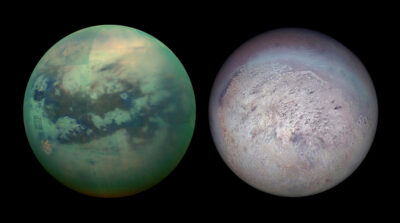Table of Contents
The solar system we live in includes the Sun, 8 planets and more than 200 satellites and nearly a million of asteroids. We clearly know what the sun and planets are, but we might confuse asteroid and satellite (moons) concepts.
Satellites (moons) are celestial bodies orbiting any planet or dwarf planet. The solar system hosts interesting similarities in moons as well as in many other celestial bodies.
One of the examples that can be given to these is the similarities between Titan (Saturn) and Triton (Neptune).
Titan
It is Saturn’s largest moon. Titan has outstanding features compared to other satellites.
The main reason for this is the only known celestial body outside the Earth, which has a substantial atmosphere and liquid rivers and lakes on its surface like in the Earth.
The atmosphere of Titan consists mainly of nitrogen. This is the fundamental difference of the Earth with the atmosphere. Clouds and rains also occur in the Patmosphere of Titan.
But it rains methane and ethane, not the water. In this satellite, water can only be found as ice. The reason for this is that the average temperature is -179 °C.
Triton
Triton is Neptune’s largest moon. The most important difference that makes Triton different from other satellites is its axis rotating in the opposite direction of its planet’s rotational direction.
Based on this feature, we can assume that Triton was included in Neptune from a local nebula.
We observe that some parts of Triton are bright and white like snow on the poles of the Earth.
The explanation for this is the newly poured nitrogen snow because the air temperature is -235 °C, even the nitrogen on this moon is frozen.
Why do these two satellites look alike?
To understand the similarity of these two satellites, we first need to look at the differences between them.
The most important difference between these satellites is the distance from the Sun. Due to this distance gap, there is a 56 °C temperature difference between them.
The biggest result of this 56 °C difference is the state of nitrogen in the satellites. The nitrogen element boils at -195.79 °C (77.36 °K); If it is -210 °C (63.15 °K), it freezes. For this reason, it is raining in Titan while it is snowing in Triton.
If so, why are these planets alike? We can answer this question as follows; If we could take the Triton satellite and put it in the place of Titan, the snow on it melts and turns into liquid nitrogen. Rivers and lakes are formed, just like in Titan.
When we compare these two satellites, it is obvious that they have also different features. Triton is about one in two of Titan. There is also a gap difference between the orbital distances.
But one of the most important similar features of these satelites are their density. Some scientists argue that these two satellites are in the same satellite group.
It is very intriguing to find such similarities in the solar system. Scientists believe that celestial bodies that can be found behind Pluto will increase these and similar situations, and will facilitate understanding of these situations.
References
- https://science.nasa.gov/
- Pale Blue Dot: A Vision of the Human Future in Space Carl Sagan


